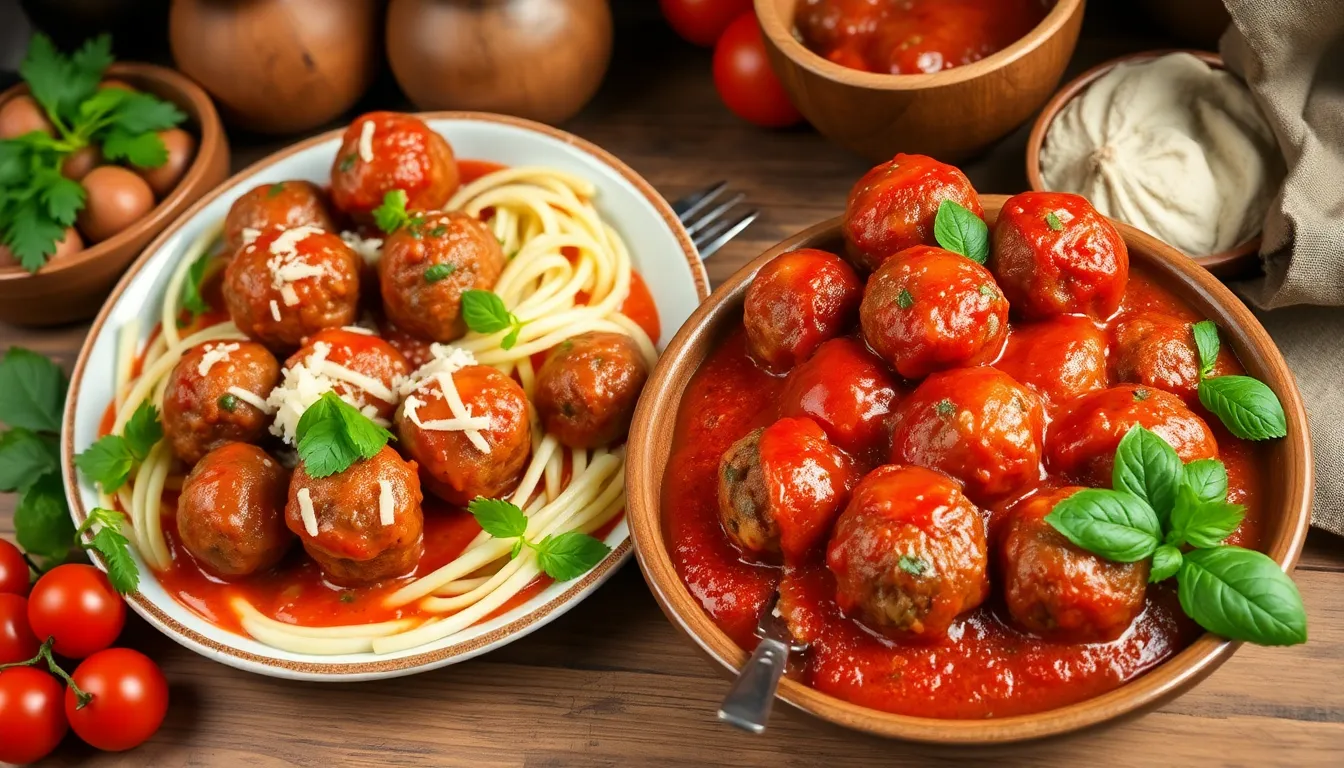Table of Contents
ToggleWhen it comes to comfort food, nothing quite hits the spot like a plate of authentic Italian meatballs. These savory delights are more than just a meal; they’re a culinary hug that warms the soul and satisfies even the pickiest eaters. But let’s be honest: not all meatballs are created equal. The secret to true Italian meatballs lies in the balance of flavors, textures, and a dash of love from nonna’s kitchen.
Overview of Italian Meatballs
Authentic Italian meatballs represent a culinary tradition that showcases rich flavors and satisfying textures. Various regional recipes exist, each adding its unique twist to this beloved dish. Ingredients often include ground meat, breadcrumbs, herbs, and cheese, creating a delightful balance.
Flavor profiles vary significantly across Italy. For instance, Southern Italian versions tend to incorporate spicy elements such as red pepper flakes. Conversely, Northern Italian meatballs often focus on milder flavors, highlighting fresh herbs like basil and parsley.
Meat quality plays a crucial role in achieving the perfect meatball. Selecting a blend of meats, like beef and pork, can enhance moisture and flavor. Additionally, using freshly grated cheese, such as Parmigiano-Reggiano, provides a more authentic taste compared to pre-packaged alternatives.
Cooking techniques also differ. Some recipes suggest pan-frying meatballs for a crisp exterior, while others advocate for baking them to retain moisture. Simmering meatballs in a rich tomato sauce allows them to absorb additional flavor, resulting in a hearty dish.
Traditional family recipes often emphasize the importance of technique and timing. Allowing enough time for flavors to meld enhances the taste experience. Following these authentic methods, one can create meatballs reminiscent of those enjoyed in Italian homes for generations.
Collectively, these elements contribute to the authenticity of Italian meatballs, making them a cherished dish worldwide. The focus on quality ingredients and preparation techniques ensures they remain a delectable choice for any meal.
Regional Variations of Meatballs

Italian meatballs showcase regional diversity, reflecting local ingredients and traditions. Each area contributes distinct characteristics to this beloved dish.
Northern Italian Meatball Recipes
Northern regions emphasize milder flavors. Recipes often feature a combination of beef and veal, enhancing tenderness. Ingredients include fresh herbs like parsley and basil, along with grated Parmesan cheese for added richness. Many chefs prefer baking meatballs, allowing for even cooking. Classic sauces, such as creamy mushroom or natural gravy, complement these meatballs beautifully, creating a comforting, hearty meal.
Southern Italian Meatball Recipes
Southern recipes embrace bold, spicy flavors. Ground pork often serves as the base, with fennel and red pepper flakes for extra zest. Ingredients like breadcrumbs come from day-old bread, contributing a rustic touch. Pan-frying remains a popular cooking method, creating a crispy exterior that locks in moisture. Tomato sauce made with garlic and fresh basil typically serves as a base, enhancing the overall richness. These meatballs carry vibrant Mediterranean influences, making them a delightful experience for the palate.
Traditional Ingredients Used
Authenticity in Italian meatballs stems from traditional ingredients, each playing a crucial role in flavor and texture. Varieties of meats, herbs, and spices create unique profiles across regions in Italy.
Meat Choices
Ground beef and pork form the foundation of many authentic meatball recipes. Italian cooks often blend these meats for enhanced moisture and richness. Veal also appears in Northern recipes, offering a milder flavor that pairs well with delicate sauces. Choosing higher-quality meats elevates the dish, ensuring a satisfying taste upfront. Some regions, especially in the South, opt for ground pork for its robust flavor, reflecting local culinary preferences.
Herbs and Spices
Key herbs and spices contribute significantly to the flavors of Italian meatballs. Fresh parsley and basil frequently add brightness, while garlic delivers a savory punch. Oregano, often associated with Italian cuisine, enhances the overall aroma. Northern variations might include sage, which complements the milder meats well. Red pepper flakes sometimes incorporate heat in Southern recipes, further distinguishing regional styles. Each selected herb or spice fosters a deeper connection to Italy’s rich culinary tradition.
Cooking Methods for Authentic Meatballs
Cooking methods significantly influence the flavor and texture of authentic Italian meatballs. Many traditional recipes highlight two primary techniques: baking and frying.
Baking vs. Frying
Baking allows meatballs to cook evenly, retaining moisture while developing a subtle crust. Marvelous results occur when meatballs bake at 375°F for about 20-25 minutes. Alternatively, frying provides a crispy exterior, enhancing the overall texture. For frying, heat oil in a skillet over medium heat and cook meatballs until browned, roughly 5-7 minutes per side. Recipes vary in preference, with Southern variations often favoring frying to achieve bold flavors, while Northern styles embrace baking for a softer bite.
Slow Cooking Techniques
Slow cooking techniques create depth in flavors and tenderness. Using a slow cooker or simmering on the stove infuses meatballs with tomato sauce or broth over several hours. Hearty recipes often suggest cooking on low heat for 4 to 6 hours, allowing the meatballs to meld with the sauce. Styles differ across regions, where some emphasize spices and tomatoes, while others focus on herbs and lighter broths. This method ensures that flavors penetrate every bite, resulting in a richer and more satisfying dish.
Pairing Suggestions
Authentic Italian meatballs pair well with a variety of accompaniments that enhance their flavor.
Sauces to Accompany Meatballs
Marinara sauce stands out as a classic pairing, offering a rich and tangy complement. Bolognese sauce provides a meaty depth that enhances the overall experience. Pesto can add a fresh, herbaceous note, while creamy Alfredo sauce brings a luxurious touch. Each sauce brings out different aspects of the meatball, allowing for varied dining moments.
Side Dishes to Serve
Serving Italian meatballs alongside spaghetti creates a traditional Italian meal. Garlic bread adds a crunchy counterpart, perfect for soaking up sauce. A fresh salad with mixed greens offers a bright contrast, balancing richness with crisp textures. Roasted vegetables provide a colorful and nutritious side, enhancing the meal’s appeal. Each choice creates a memorable dining experience that highlights the comfort of meatballs.
Authentic Italian meatballs are more than just a dish; they embody a rich culinary heritage that resonates with comfort and tradition. Each regional variation offers a unique twist that showcases the diverse flavors of Italy. Whether it’s the bold spices of the South or the milder notes from the North, these meatballs highlight the importance of quality ingredients and careful cooking techniques.
By embracing traditional recipes and methods, anyone can create a satisfying meal that captures the essence of Italian cuisine. With the right pairings and sides, Italian meatballs can transform any dining experience into a celebration of flavor and warmth.




